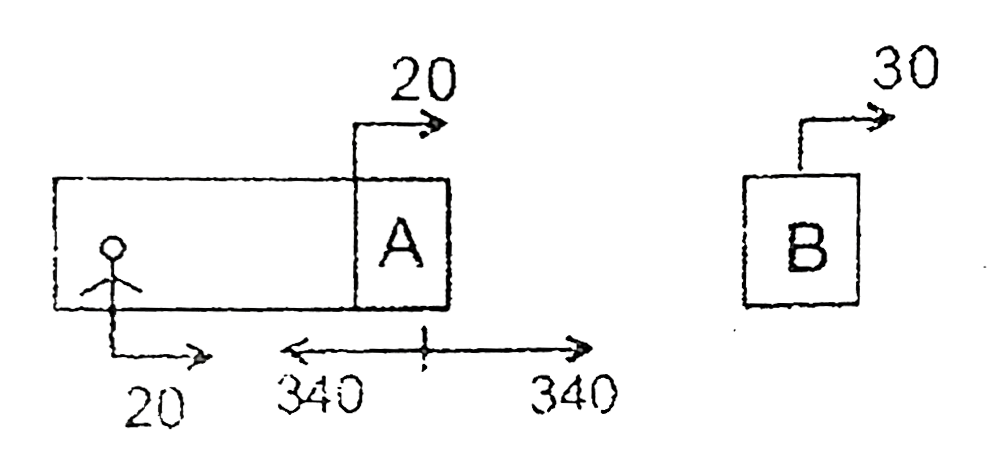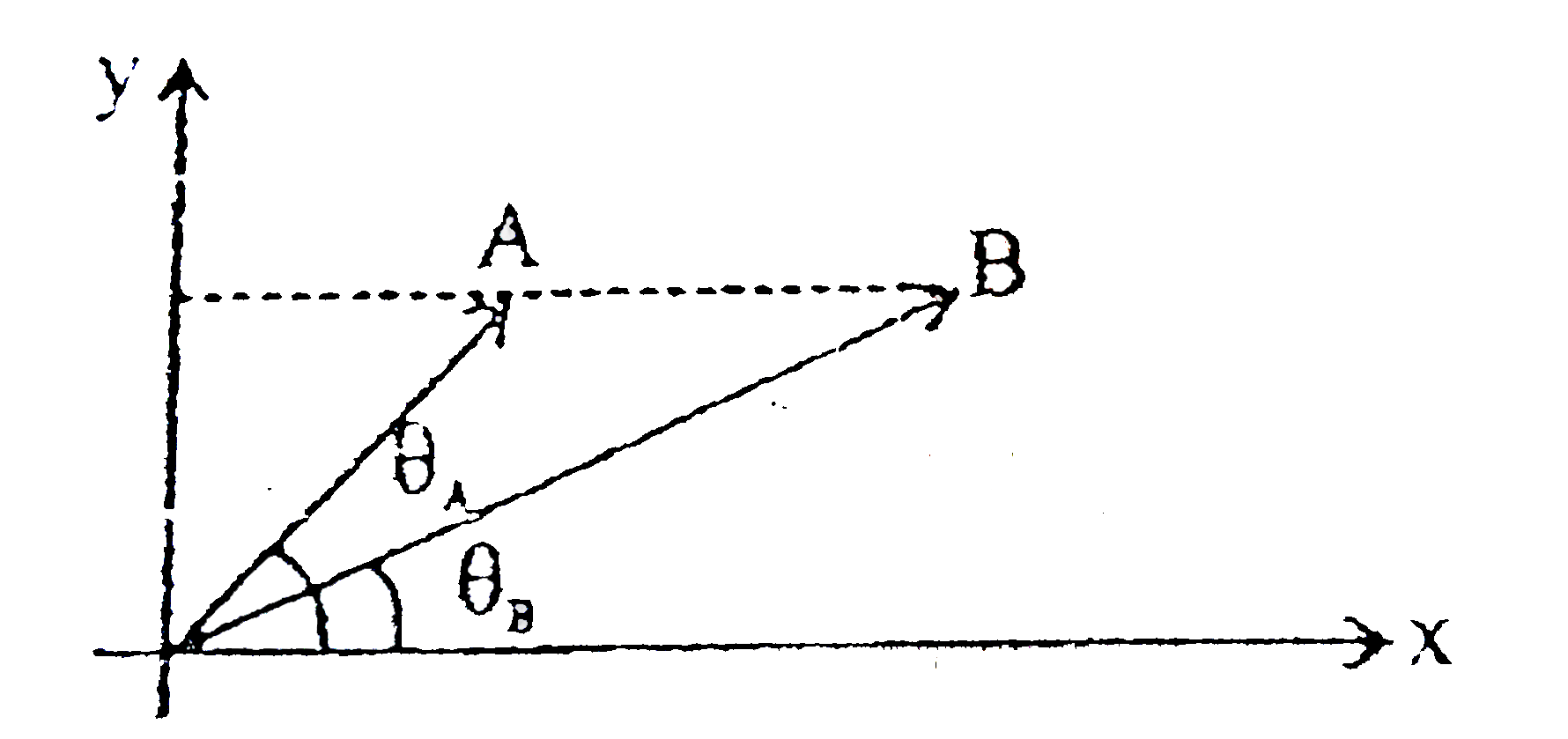Two trains A and B are running in the same direction on the parallel rails such that A is faster than B. Packets of equal weight are transfcrred from A to B. What will happen due to this :
A will be accelerated but B will be retarded.
B will be accelerated but A will be retarded
there will be no change in A but B will accelerated.
there will be no change in B, but A will be accelerated
The correct Answer is:B
To solve the problem, we need to analyze the situation involving two trains, A and B, moving in the same direction, where train A is faster than train B. We will also consider the effect of transferring packets of equal weight from train A to train B.
1. Understanding the Initial Conditions:
- Let the speed of train A be VA and the speed of train B be VB.
- Given that VA>VB, train A is moving faster than train B.
2. Momentum Consideration:
- The momentum of an object is given by the product of its mass and velocity. For train A, the momentum is PA=mA⋅VA, and for train B, it is PB=mB⋅VB.
- When packets of equal weight are transferred from A to B, the mass of train A decreases while the mass of train B increases.
3. Effect on Train A:
- As packets are transferred from train A to train B, the mass mA of train A decreases. Since the velocity VA remains the same initially, the momentum PA of train A decreases.
- According to Newton's second law, a decrease in momentum over time implies that the acceleration of train A is negative (retardation).
4. Effect on Train B:
- Conversely, as packets are added to train B, its mass mB increases. The velocity VB remains the same initially, but the momentum PB of train B increases.
- An increase in momentum over time indicates that the acceleration of train B is positive (acceleration).
5. Conclusion:
- Therefore, as packets are transferred from A to B, train A will experience a decrease in momentum leading to retardation, while train B will experience an increase in momentum leading to acceleration.
- The correct option is that train B will be accelerated and train A will be retarded.
Final Answer:
B will be accelerated and A will be retarded.
---
- Let the speed of train A be VA and the speed of train B be VB.
- Given that VA>VB, train A is moving faster than train B.
- The momentum of an object is given by the product of its mass and velocity. For train A, the momentum is PA=mA⋅VA, and for train B, it is PB=mB⋅VB.
- When packets of equal weight are transferred from A to B, the mass of train A decreases while the mass of train B increases.
- As packets are transferred from train A to train B, the mass mA of train A decreases. Since the velocity VA remains the same initially, the momentum PA of train A decreases.
- According to Newton's second law, a decrease in momentum over time implies that the acceleration of train A is negative (retardation).
- Conversely, as packets are added to train B, its mass mB increases. The velocity VB remains the same initially, but the momentum PB of train B increases.
- An increase in momentum over time indicates that the acceleration of train B is positive (acceleration).
- Therefore, as packets are transferred from A to B, train A will experience a decrease in momentum leading to retardation, while train B will experience an increase in momentum leading to acceleration.
- The correct option is that train B will be accelerated and train A will be retarded.
B will be accelerated and A will be retarded.
Topper's Solved these Questions
- CENTRE OF MASSBook:DC PANDEY ENGLISHChapter:CENTRE OF MASSExercise:Assertion and reason
Explore 21 Videos
- CENTRE OF MASSBook:DC PANDEY ENGLISHChapter:CENTRE OF MASSExercise:Match the coloumns
Explore 9 Videos
- CENTRE OF MASSBook:DC PANDEY ENGLISHChapter:CENTRE OF MASSExercise:Check points
Explore 50 Videos
- CALORIMETRY AND HEAT TRANSFERBook:DC PANDEY ENGLISHChapter:CALORIMETRY AND HEAT TRANSFERExercise:Medical entrance s gallery
Explore 38 Videos
- CENTRE OF MASS, IMPULSE AND MOMENTUMBook:DC PANDEY ENGLISHChapter:CENTRE OF MASS, IMPULSE AND MOMENTUMExercise:Comprehension type questions
Explore 15 Videos
Similar Questions
Two trains A and B are running in the same directions on parallel tracks such that A is faster than B, packets of equal weight are exchanged between them. Then
View SolutionTwo trains A and B are moving with speeds 20m/s respectively in the same direction on the same stright track, with B ahead of A. The engines are at the front ends. The engines of train A blows a long whistle.
Assume that the sound of the whistle is composed of components varying in frequency from f1=800Hz to f2=1120Hz, as shown in figure. The speed in the frequency (highest frequency - lowest frequency) is thus 320Hz. The speed of sound in still air is 340m/s.

The spread of frequency as observed by the passengers in train B is
View Solution
Knowledge Check
Two springs A and B are identical except that A is stiffer than B i.e., kA>kB. If the two springs are stretched by the same force, then
Amore work is done on B i.e., WB>WABmore work is done on A i.e., WA>WBCwork done on A and B are equalDwork done depends upon the way in which they are stretched
If A and B are any two square matrices of the same order than ,
View SolutionTwo trains A and B are moving in the same direction with velocities 30 m/s and 10 m/s respectively, B is behind from A, blows a horn of frequency 450 Hz. Then the apparent frequency heard by B is (The velocity of sound is 330 m/s) :-
View SolutionTwo trains A and B 100 m and 60 m long are moving in opposite direction on parallel tracks. The velocity of the shorter train is 3 times that of the longer one. If the trains take 4s to cross each other, the velocities of the trains are
View SolutionTwo motor boats A and B move from same point along a circle of radius 10 m in still water. The boats are so designed that they can move only with constant speeds. The boats A and B take 16 and 8 sec respectively to complete one circle in stationary water. Now water starts flowing at t=0 with a speed 4ms in a fixed direction. Find the distance between the boats after t=8 sec.
View SolutionTwo particles A and B are projected from the same point in different direction in such a manner that their velocity vectors are shown in the diagram :−
 .
.
View SolutionIf A and B are two invertible matrices of the same order, then adj (AB) is equal to
View SolutionTwo circular, similar, coaxial loops carry equal currents in the same direction. If the loops are brought nearer, what will happen?
View Solution